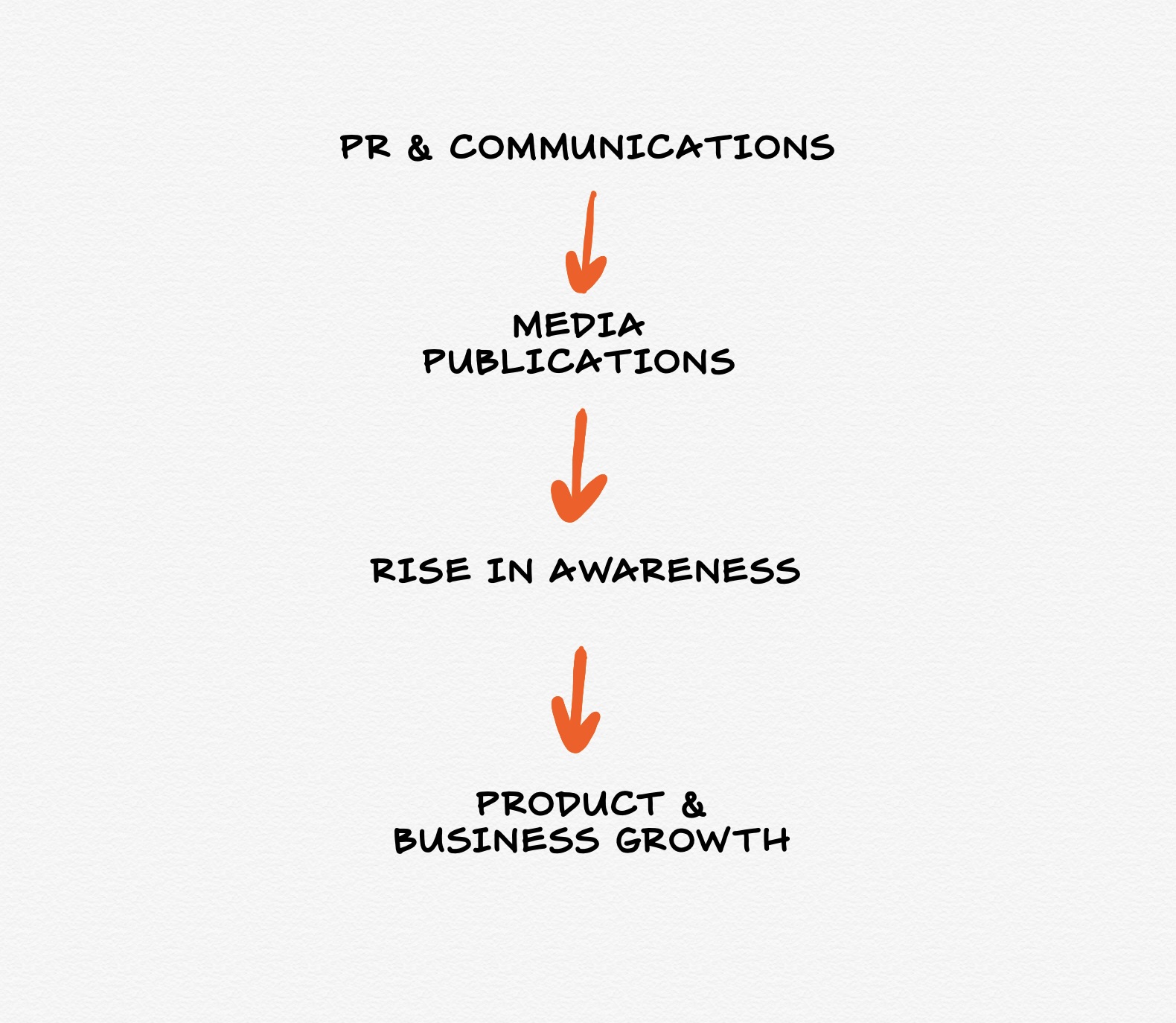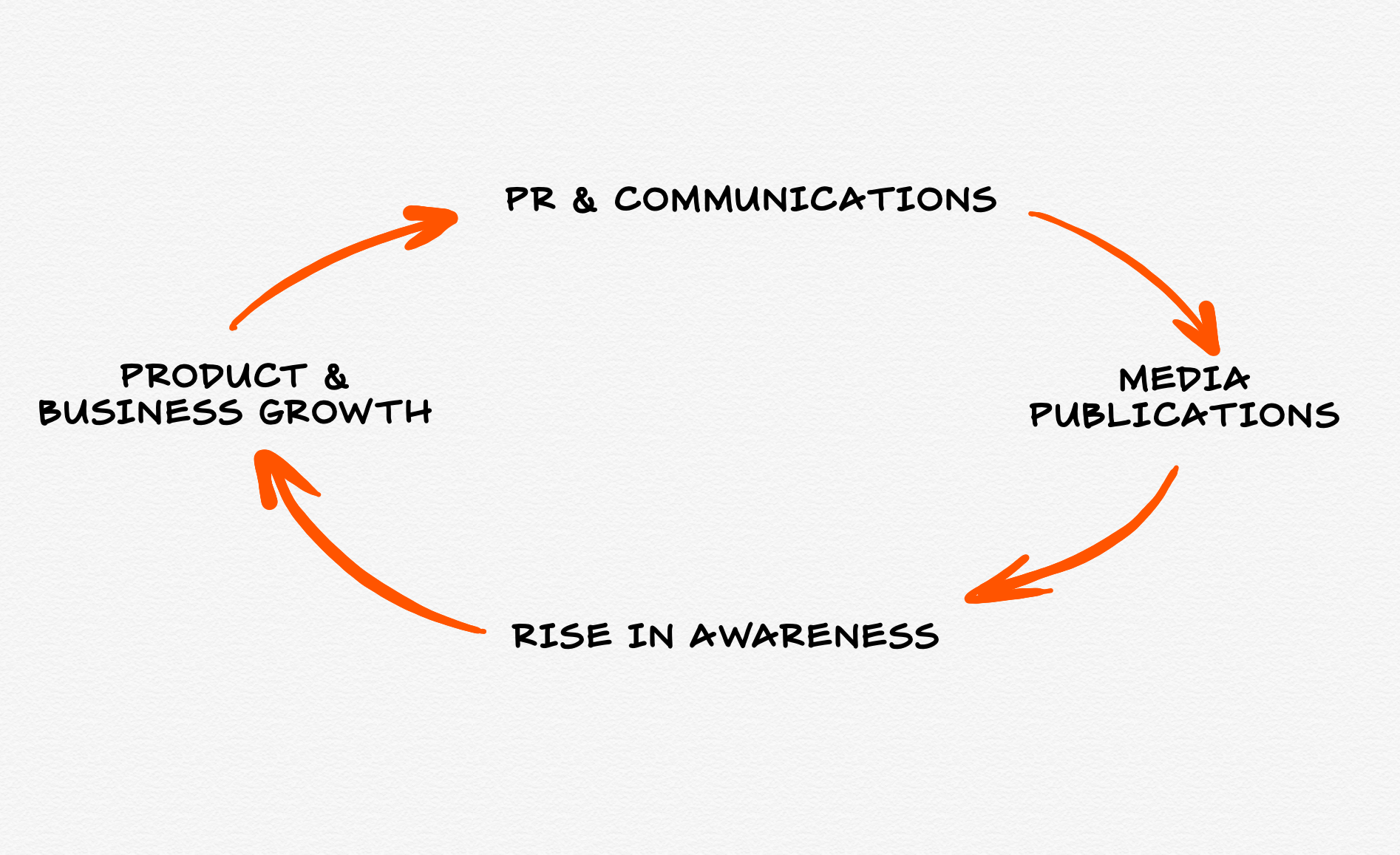The PR Flywheel: What It Can And Can’t Do For Your Business
People often think that PR and communications alone can help them achieve their goals and end up surprised when it doesn’t move the needle as much as they wanted. In fact, it’s a bit more complicated. PR is only a part of the virtuous circle.
People often think that PR and communications alone can help them achieve their goals and end up surprised when it doesn’t move the needle as much as they wanted.
It’s because they think of communications like this. As if it’s something that can single-handedly drive awareness, attract customers, and bring money right away.

In my experience, it’s a bit more complicated. PR is only a part of the virtuous circle. To secure an article in a good media publication, we need to convince journalists that your business will interest their readers. So we craft a compelling story by using everything at our disposal: from the founders’ journey and unique aspects of the product to the best metrics as validation from your customers and users.
Journalists like great stories. And exciting numbers, along with the intangible public perception, are part of that story. They love to catch trends early and predict the next big thing. They also don’t want to be wrong, so they’re unlikely to over-inflate something unless they truly believe in it.
If your competitor is ten times larger than you, you shouldn’t expect the quantity and quality of your media coverage to be the same. If Twitter, Reddit, and Discord servers are buzzing with invites to their product, and you can’t say the same for yourself, it’s natural for reporters to give more attention to them. You move past this by building something truly novel and communicating it better.
Your startup’s success translates into good media coverage. These articles might help you with solving specific business objectives, such as pre-warming your relationships with customers and partners through word of mouth, finding the next investors, and convincing a developer to join your startup. You grow, and then this growth by itself validates your story and makes the company even more interesting.
This is the flywheel of communications.

You just need to keep going*.
I’m not saying that if you aren’t getting the results, you just need to keep paying someone, an in-house head of communications, or a hired agency. Some companies are naturally more predisposed to PR because of their industries, founders, products, etc.
Good communications allow you to jump a little over your head. People notice you when a top-tier media publication posts a nice article about your startup. It creates buzz. It inflicts a bit of FOMO in investors looking for the most exciting deal. It instills confidence in potential candidates. It might even help you convince some partners.
But a single news article won’t make your startup a unicorn. Communications are about realizing the inherent potential. The story with all the substance is already there, all we do is shape it to deliver the idea in the most succinct way possible.
The paths of Stripe and Adyen are probably the best example. Both do very similar things: they help businesses accept payments on the Internet. Even though Adyen is older, it stayed in the shadow (comparatively speaking) for most of its existence. Then, in 2022 Adyen suddenly surpassed Stripe in payments volume, turned out to be more profitable, and didn’t have to do layoffs afterward. But they were quite comparable even earlier.
One of the reasons Stripe was more notable and well-known is because it was much better at communications. Their “increasing the GDP of the Internet” tagline presents an exciting and ambitious vision. Sounds much better than a “card processing company” or a “payments acquirer”.
Remember, you can’t jump too high. There’s a cautionary tale of Fast, whose founder was a great communicator, built an image of a successful, thriving company, and raised $100 million from Stripe. He was loved by the media for a little while, but then the same industry crushed him when they got access to the actual state of finances in the company.
Take what you’re and think of the most exciting way to present this story. Look at what your peers are doing as a reference, but focus on what makes you unique. Distill your pitch to highlight your mission and validate it with anything you might have, including the founders’ expertise, the rapid growth of your user base, or anything else.
Remember, that most of the time, journalists write news. Something that happened. The fact of your company’s existence is unlikely to be newsworthy by itself. Look at your product roadmap as well as anything you’ve already achieved. Also, think if there’s anything you deeply know and truly believe yet nobody talks about it yet, as it could become a good contributed story or an angle for something bigger.
***
This was first posted on our blog at MA Family.




